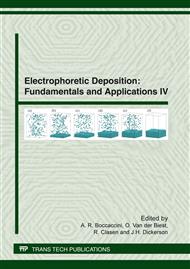p.181
p.191
p.197
p.203
p.209
p.215
p.221
p.227
p.233
Development of Internal Stresses in Alumina-Zirconia Laminates
Abstract:
The laminated ceramics can provide a flaw tolerant behaviour compare to the monolithic ceramics. Two ways how to ensure flaw tolerant behaviour of layered materials are known. The first is based on production of weak interfaces between layers allowing delamination without catastrophic failure. The second way, on the contrary, uses strong bond between layers ensuring high strength and stiffness. The presence of internal stresses developed due to differences in shrinkage of individual layers can effectively change the crack path or even more to stop the crack propagation. Laminated structures with strong bond between layers can be prepared by various methods including tape casting, slip casting and last but not least by electrophoretic deposition. The electrophoretic deposition is probably the most suitable method which is able to create sharp and therefore strong interface in wide range of preciously set layer thicknesses. This contribution demonstrates a way how to determine level of internal stresses based on combined numerical simulation and dilatometric measurements. For this purposes alumina and zirconia monoliths and laminates were prepared. The numerical model of laminated structure using measured data was created for FEM simulation to obtain a stress distribution.
Info:
Periodical:
Pages:
221-226
Citation:
Online since:
March 2012
Authors:
Keywords:
Price:
Сopyright:
© 2012 Trans Tech Publications Ltd. All Rights Reserved
Share:
Citation:


